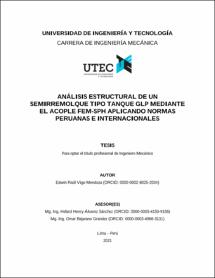Análisis estructural de un semirremolque tipo tanque GLP mediante el acople FEM-SPH aplicando normas peruanas e internacionales
Abstract
El Perú es un país con una demanda de Gas Licuado de Petróleo en constante crecimiento, ya que este recurso representa el 10% de su demanda energética y como tal el sector más promisorio en este sentido es el sector vehicular, ya que su tasa de crecimiento anual oscila en un 4% respecto a 2019. En base a esta premisa resulta recomendable considerar que la metodología preferida en la industria para distribuir el hidrocarburo (Gas Licuado de Petróleo-GLP) desde la planta de almacenamiento es mediante la flota vehicular: Rígida o Articulada. Por ello, el Organismo Peruano de Consumidores y Usuarios (OPECU) realizo una estadística demostrando que a nivel nacional circulan 1 523 unidades vehiculares para el transporte del GLP [1], sin embargo, ello enfrenta la irregularidad en cuando a la fabricación vehicular puesto que hasta el momento se carece de alguna regulación nacional tanto para el diseño como para la fabricación. En tal sentido en este documento se presenta una propuesta optima de diseño del Semirremolque tipo tanque GLP (definición atribuida por la normativa peruana [2]), así como la descripción de conceptos físicos arraigados a la respuesta estructural en la dinámica del chapoteo ante un frenado inminente. Lo cual se realizó cumpliendo las regulaciones establecidas por entidades nacionales como el Ministerio de Energía y Minas (MINEM) y el Ministerio de Transportes y Comunicaciones (MTC), y complementado con especificaciones norteamericanas como el Departamento de Transportes de los Estados Unidos (DoT) y la Sociedad Americana de Ingenieros Mecánicos (ASME). Peru is a country with a demand for Liquefied Petroleum Gas in constant growth since this resource represents 10% of its energy demand and as such the most promising sector in this sense is the vehicle since its growth rate annual oscillates 4% compared to 2019 [1]. Therefore, it should be considered that the preferred methodology in the Peruvian industry to distribute the hydrocarbon (Liquefied Petroleum Gas-LPG) from the storage plant is through the vehicle fleet: Rigid or Articulated. For this reason, the Peruvian Agency for Consumers and Users (OPECU) carried out a statistic showing that 1,523 vehicular units circulate nationwide for the transport of LPG [1], however, this confront the irregularities when it comes to vehicle manufacturing since up to now there is no national regulation for both design and manufacturing. In this sense, this document presents an optimal proposal for the design of the LPG tank semi-trailer (definition attributed by Peruvian regulations [2]), as well as the description of physical concepts rooted in the structural response in the dynamics of sloshing before imminent braking. Which was done in compliance with the regulations established by national entities such as the Ministry of Energy and Mines (MINEM) and the Ministry of Transportation and Communications (MTC) and complemented with North American specifications such as the Department of Transportation of the United States (DoT) and the American Society of Mechanical Engineers (ASME).
Citation
Vigo Mendoza, E. R. (2021). Análisis estructural de un semirremolque tipo tanque GLP mediante el acople FEM-SPH aplicando normas peruanas e internacionales [Tesis de Título Profesional, Universidad de Ingeniería y Tecnología]. Repositorio Institucional UTEC. https://hdl.handle.net/20.500.12815/339Subject
Collections
- Ingeniería Mecánica [73]


